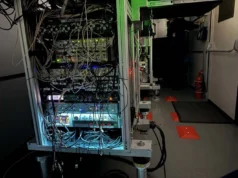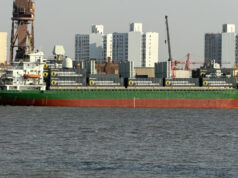HMS Cattistock found more than ten mines and torpedoes from the Second World War during a search for unexploded wartime bombs as part of a NATO task group.
According to a press release:
“Norway was occupied by the Nazis between April 1940 and the war’s end, with the RAF making repeated attempts to disrupt shipping between Oslo and Germany – an operation codenamed ‘gardening vegetables’, with Oslofjord itself also given the cover name ‘onions’.
Twin-engine Hampden bombers, or four-engine Lancasters and Halifaxes dropped between one and two dozen mines at a time, just one or two seconds apart from a mere 600ft over the fjord. Around 1,500 British ‘A’ mines were sown in the fjord and its many inlets – some triggered by a ship’s magnetic field, others by the noise vessels made as they passed overhead.”
Leading Diver Karl Atkin said:
“The environmental conditions were incredibly challenging – water temperatures down to freezing, often causing the formation of ice, and air temperatures consistently well below freezing. So diving operations were unusually demanding. We often went down to 60 metres in zero visibility and had to identify the mines by touch.
The deep dives bring a heavy decompression penalty too – we had to conduct ‘stops’ at various depths on the way up. When we do, we’re motionless in the water column and get very cold very quickly! The cold also forced the ship to abandon the last two miles of hunting due to thick sea-ice closing the bay.”













[…] post HMS Cattistock clears mines around Norwegian capital Oslo appeared first on UK Defence […]
As a guy who learnt to dive and had some military diving training as a civvy, those conditions are terrifying. I take my hat off to commercial and military divers who go down to such depths in almost intolerable conditions. Balls of steel!
Balls of ice, more like! lol
It’s good to see Cattistock as part of SNMCMG1. With other MCM deployments in the past, like in the Gulf, the RN had (understandably) not had so much to do with that standing group, but the RN does need to look more to the Baltic.
The RN always contributes 1 MCN to SNMCMG1. In addition to the 4 deployed in the Gulf permanently and 2 standing by for home duties.
Well done to everyone involved and the sense of accomplishment should have been pretty huge. It’s always nice to see highly trained combat personnel work for the betterment of a community and show it’s not all about battle.
I imagine the entire crew were happy with this assignment.
With reference to other posts and articles regarding Mine Sweeping drones. Here is a reason why drones cannot do everything. Yes drones could have been used to localize the offending object but even with say Seafox you still need people to get wet and a vessel that has a TMCC Pot on board for decompression and diver support.
Morning Gunbuster
Whilst I am sure that your logic is sound and I also fully recognise that drones cannot do everything the RN is under huge strain to deliver all of its core capabilities.
You will have seen in the press over the last couple of weeks themes being discussed like Global Britain, International by Design, innovation and lastly working and integrating with partners to deliver effect.
You will have also seen the announcement that boat 7 is being ordered and it is likely that the RM and supporting amphibious shipping will survive (the political cost is just too great) so something will have to give.
All that is left are the legacy platforms sat along side at Pompey, the MCMV fleet and some auxiliary vessels.
Anyone that thinks that U.K. industry can deliver 5 T31’s to time and cost are also amazingly optimistic so money will also be needed for that.
Clearing mines for other nations is a great bit of PR and highlights the great professionalism of the teams doing the work but the senior leadership within the RN are all currently fixated on getting two massive aircraft canoes out the door.
They also have to deliver the deterrent and the CDEL cost for that is going through the roof.
For the RN to keep doing what it does best (above is a great example) either the RN needs to gives up capability or HMT has to remove the CDEL cost of the deterrent out of the core budget.
If given the choice of maintaining the deterrent and CVF over the MCMV fleet I know which one they will pick.
The Bombers should never have come into the core budget to begin with. They should have remained outside as a separate funded project.
I too have my doubts on T31…on budget and on time will be a big order for what ever version is chosen and the companies building it.
Ampibs must stay, not just because my last ship in the RN was Bulwark but because I have seen their flexibility first hand on ops and showing the flag and know what they can do.
Rumors where abound that a T23 was going to come to the ME and be on permanent station this year with crew rotation. That would release at least one MCMV possibly two to return to the UK. It would also reduce the need for a T45 to come out this way as well.
All the RN is focused on at present is getting QE operational and on a global in 2020. Everything is focused on that. Escort availability, RFA cover , aircraft etc are all aiming for that one goal. Its pretty sad that evrything else is taking a back seat for the next 2 years…Carrier Queens…they never change!
I suspect these are the best value assets in the RN from a cost to operations perspective and I would prefer to see them replaced like for like, but given where we are and the need for more escorts I just can’t see the MCMV force surviving in its current state, which is a real pity. I see this force operating from a mother ship in future with all the divers and tooling, perhaps with one of these but the rest being all Uv’s.
I accept your point about people, divers etc but am pretty sure these can all be deployed from an Atlas configured appropriately. Only time will tell
The British still clearing up the mess by the nazis keep safe lads .why are Germany not doing this clear up ?
As the article states, many of the mines were dropped by the RAF to disrupt shipping ( and they did a bloody good job as they’re still disrupting shipping nearly 80 years later!)